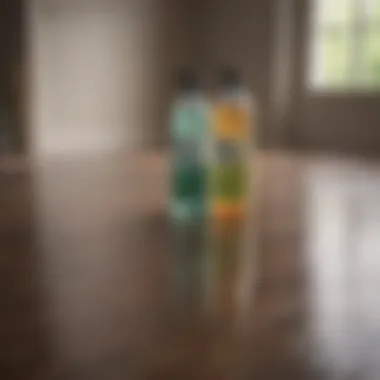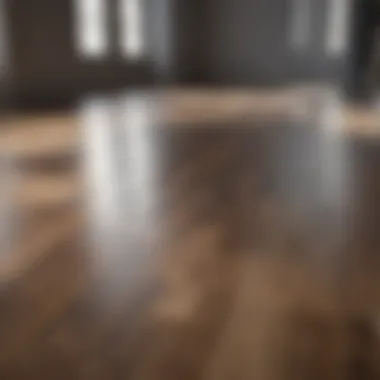Essential Cleaning Methods for Laminate Floors


Intro
Laminate flooring has gained popularity for its versatility and affordability. It mimics the look of hardwood while providing durability and ease of maintenance. Understanding how to properly clean and maintain laminate floors is essential for prolonging their lifespan and preserving their aesthetic appeal. Homeowners often encounter challenges when cleaning these surfaces, so this guide aims to clarify effective methods and recommended products.
Cleaning laminate floors requires attention to detail, as the wrong techniques can lead to damage. Utilizing the right strategies ensures a cleaner environment without compromising the flooring material. In this article, we will explore the various cleaning methods tailored to laminate floors, delve into potential product pitfalls, and provide maintenance tips that support long-term health and beauty of these surfaces.
Prelude to Laminate Flooring
In the realm of interior design and home maintenance, understanding laminate flooring is fundamental for both homeowners and enthusiasts. Laminate flooring has gained popularity for its aesthetic appeal and practical advantages. This introduction serves as an essential step in exploring the cleaning methods for this surface.
Understanding Laminate as a Material
Laminate flooring is made from layers of synthetic materials fused together. It typically consists of a base layer, a core layer, and a protective wear layer. The top layer is often designed to mimic the appearance of wood or stone, making it a versatile choice for many homes. This synthetic material is engineered for durability, which is one reason it has become a preferred option for floors.
Furthermore, laminate flooring is generally resistant to fading, stains, and moisture, provided it is installed correctly. However, it is crucial to note that while laminate can withstand everyday use, it is not entirely immune to damage from excessive moisture or harsh cleaning methods.
Advantages of Laminate Flooring
There are several advantages to choosing laminate flooring that make it an effective choice for various spaces:
- Cost-Effectiveness: Compared to solid hardwood or tile, laminate is often more affordable without sacrificing appearance.
- Variety of Designs: Homeowners can find laminate in many designs, enabling them to achieve the desired aesthetic.
- Easy Installation: Many laminate products are designed for quick and straightforward installation, sometimes without the need for professional assistance.
- Low Maintenance: The cleaning and upkeep of laminate floors are simpler than other options. Regular maintenance can keep these floors looking good over time.
- Environmental Considerations: Some laminate products use recycled materials, making them a more eco-friendly option compared to traditional hardwood floors.
This overview emphasizes the importance of understanding laminate flooring's characteristics and benefits before diving into cleaning methods. By recognizing its properties, one can better appreciate the techniques needed to maintain its visual appeal and functional integrity.
Cleaning Challenges Faced with Laminate Floors
Cleaning laminate floors requires attention due to several unique challenges that arise from their material composition. Although laminate is designed to withstand everyday wear and tear, its cleaning needs can vary significantly from other surfaces such as hardwood or tile. Understanding these cleaning challenges is crucial for maintaining the aesthetic appeal and longevity of the flooring.
Common Stains and Spills
Laminate floors can be prone to various stains and spills, especially in environments where food and drink are frequently present. Common culprits include:
- Coffee: Dark beverages can leave unsightly marks if not cleaned promptly.
- Juice: Sugar content can lead to stickiness if not addressed quickly.
- Food: Crumbs and spills from cooking can become gummy and attract dirt.
- Mud and Dirt: Often tracked in from outside, these can leave streaks and discoloration if allowed to dry.
To effectively manage these stains, immediate response is key. Simple steps like blotting fresh spills with a clean cloth can help minimize absorption. For tougher stains, a mixture of water and vinegar can be effective. However, caution is necessary as excessive liquid can lead to warping or damage if allowed to seep through the seams.
Scratch Resistance and Its Limitations
Laminate flooring does boast some level of scratch resistance, owing to its protective wear layer. However, this resilience is not foolproof. Heavy furniture, pet claws, and sharp objects can still cause noticeable scratches. Understanding the limitations of laminate’s scratch resistance is essential for homeowners and enthusiasts alike.
Consider these factors to protect your floors:
- Use Furniture Pads: Placing soft pads under furniture can help prevent scratching.
- Avoid Dragging: Always lift furniture instead of dragging when rearranging.
- Regular Inspection: Periodically check for scratches to address them before they become larger issues.
"While laminate floors are durable, their aesthetic can suffer from seemingly minor neglect. Regular care is essential for maintaining their appearance."


In summary, while laminate cleaning poses specific challenges, informed strategies can mitigate potential damage. Homeowners should remain vigilant about stains and scratching risks to prolong the beauty and functionality of their flooring.
Recommended Cleaning Products
Cleaning products play a vital role in maintaining the appearance and longevity of laminate floors. Using the right cleaning products ensures that the laminate surface remains free from damage, scratches, and unsightly stains. Moreover, different types of products vary in their effectiveness based on the specific challenges laminate floors present, such as moisture sensitivity and the need for gentle cleaning agents. It is essential for homeowners and enthusiasts to choose effective cleaners that do not harm the floor's finish.
Commercial Cleaners for Laminate Floors
Commercial cleaners designed specifically for laminate floors can be highly effective. They are formulated to clean without excessive moisture and protect the surface from damage. When selecting a commercial cleaner, it is important to look for products labeled as safe for laminate. These cleaners often contain special ingredients that avoid leaving residues and enhance shine. Following the manufacturer's instructions for use is crucial to achieving optimal results and avoiding unnecessary damage. Some recommended brands for laminate floor cleaning include Bona and Armstrong. These products can contribute to the overall aesthetic by providing a clean and polished look to the floor.
Homemade Solutions: A Practical Approach
Many homeowners prefer homemade cleaning solutions due to their simplicity and cost-effectiveness. Homemade solutions can be effective while often being more environmentally friendly. Here are some notable options:
Vinegar and Water Mixture
The vinegar and water mixture is a popular choice among homeowners for cleaning laminate floors. This solution typically consists of a one-to-one ratio of vinegar to water. The acidity of vinegar breaks down grime, while being gentle enough to not damage the laminate. Notably, one of its key characteristics is its availability; vinegar is readily found in many kitchens.
However, it is crucial to avoid using too much vinegar, as it can dull the floor's finish over time. To use this mixture effectively, simply dampen a microfiber cloth with the solution and wipe the floor, avoiding saturating the surface. Overall, this method is beneficial due to its affordability and effectiveness.
Baking Soda Paste
Baking soda paste is another practical solution. To create a paste, mix baking soda with a small amount of water until it reaches a thick consistency. This method shines in its ability to handle tougher stains, such as scuff marks. The key characteristic of this paste is its mild abrasive quality, allowing it to lift dirt without scratching laminate surfaces.
However, it is essential to test the paste on a small area first. If used excessively, it can leave behind a residue. This method provides a safe alternative to strong chemical cleaners, making it a popular choice for meticulous homeowners.
Essential Oils for Freshness
Essential oils can serve as a delightful addition to homemade cleaning solutions. Adding a few drops of essential oils like lavender or lemon to cleaning mixtures not only provides a pleasant scent but also can possess antimicrobial properties. The key characteristic of essential oils is their versatility; they can enhance both the cleaning experience and indoor air quality.
Nevertheless, it is vital to ensure that the chosen oils are safe on surfaces before widespread application. A small amount goes a long way, making this approach cost-efficient and beneficial. Their unique feature includes promoting an inviting atmosphere in the home, which is especially valuable for real estate enthusiasts and interior design aficionados.
Effective Cleaning Techniques
Effective cleaning techniques are foundational for preserving the aesthetic and functional integrity of laminate floors. These methods not only remove dirt and stains but also prolong the lifespan of the flooring material. Understanding the nuances of cleaning can lead to a more satisfying experience and ultimately, better results. The focus should remain on gentle yet thorough approaches that minimize the risk of damage while maximizing cleanliness.
Using a Damp Mop
A damp mop is one of the simplest yet most effective tools for cleaning laminate floors. When employing this method, it’s crucial to ensure that the mop is only lightly dampened. Excess moisture can seep into the seams of laminate, causing warping or swelling over time. This technique is effective in lifting dust and particles while maintaining the integrity of the surface. It’s advisable to use a specialized cleaner designed for laminate if necessary, or just plain water for routine cleaning.
- Start by sweeping or vacuuming the floor to remove loose debris.
- Dip the mop into the cleaning solution, wring it out to the point that it is just damp.
- Mop the floor in sections, ensuring that you go with the grain of the laminate to avoid streaks.
- Allow the floor to dry completely before walking on it.
Microfiber Cloths: A Safer Choice
Microfiber cloths have become increasingly popular among homeowners as a safer option for cleaning laminate floors. Their fine fibers are designed to trap dust and dirt without scratching the surface. Unlike traditional mops or rags, microfiber does not leave behind lint or residue, which is particularly important for maintaining the clarity of laminate finishes.
- Use microfiber cloths dry for dusting to pick up small particles.
- When applying a cleaning solution, slightly dampen the cloth to prevent excess moisture.
- Gently wipe the floor, paying attention to areas that frequently accumulate dirt or grime.


Avoiding Excessive Water Use
Excessive water use is a common pitfall in the cleaning of laminate floors. When too much liquid is used, it can result in damage due to the flooring's vulnerability to moisture. Key considerations include:
- Always opt for a damp rather than wet approach.
- Make it a point to distribute moisture evenly across the floor where necessary.
- Limit the use of water-based products unless specified for laminate.
By avoiding excess water, you ensure that your laminate floors remain in pristine condition while effectively managing cleanliness.
Tip: Regular maintenance and the right cleaning techniques can significantly increase the longevity of your laminate flooring.
In-Depth Cleaning Procedures
In-depth cleaning procedures are essential for maintaining the beauty and functionality of laminate floors. Over time, dirt and grime can accumulate in areas that regular cleaning methods may overlook. Implementing a systematic approach to deep cleaning will not only enhance the aesthetic value of the flooring but also prolong its lifespan. This section outlines how diligent cleaning contributes to both appearance and durability, providing homeowners with a clearer path to achieving pristine laminate surfaces.
Daily Maintenance Routines
Establishing daily maintenance routines is crucial for preserving the integrity of laminate floors. A simple task can prevent dirt build-up and reduce the need for intensive cleaning later on. To effectively maintain laminate floors, homeowners should follow these steps:
- Sweeping or Vacuuming: Remove dust and debris using a soft broom or a vacuum cleaner with a suitable attachment to protect the floor.
- Spot Cleaning Spills: Address spills immediately with a damp cloth to avoid damaging the surface. This prevents stains from setting.
- Using Floor Mats: Placing mats at entry points helps trap dust and moisture, reducing the amount of dirt that enters the home.
By executing these daily tasks, the floors remain looking fresh and clean, setting the stage for a less burdensome deep cleaning process.
Deep Cleaning Techniques
Deep cleaning goes beyond the surface, effectively tackling stains and accumulated grime that daily routines may miss. Here are some recommended techniques for deep cleaning laminate floors with specifics that can facilitate a successful outcome:
- Using a Damp Mop: A slightly damp mop is the best means to clean larger areas. It is crucial to avoid excessive water, as over-saturation can lead to warping or damage.
- Cleaning Solutions: Choose appropriate cleaning solutions formulated for laminate floors. Generic cleaners can cause adverse effects. A mixture of vinegar and water can be effective, but always follow up with a damp mop to rinse.
- Utilizing a Soft Cloth: For spot cleaning stubborn stains, use a soft microfiber cloth paired with a gentle cleaner. This prevents scratching the surface while getting rid of tough spots.
- Steam Cleaners: While some may consider steam cleaning for deep dirt removal, caution is required as high heat may harm the laminate surface. Always check the manufacturer’s guidelines before using such equipment.
Deep cleaning techniques ensure thorough removal of dirt and maintenance of the floor’s visual appeal. Incorporating these methods into your routine can safeguard the longevity of your laminate flooring.
"Regular and thorough cleaning will not just maintain the appearance, it also serves to protect the underlying structure of the floor."
This highlights the significance of proper cleaning methodology, which ensures laminate floors remain in optimal condition for years to come.
Mistakes to Avoid When Cleaning Laminate Floors
Cleaning laminate floors can be straightforward, yet many homeowners make decisions that can permanently damage their flooring. Understanding what mistakes to avoid is crucial not only for maintaining the appearance but also for extending the life of your floors. By highlighting these common errors, you empower yourself to take better care of your laminate surfaces. Ignoring this information can lead to costly repairs or replacements.
Avoiding Harsh Chemicals
One of the most significant mistakes is the use of harsh chemicals. Many commercial cleaners contain strong solvents and acids that can break down the laminate material. This type of damage often appears as discoloration or warping, which is hard and expensive to fix. It is important to read labels and choose cleaners specifically designed for laminate floors. Look for pH-balanced cleaners which won't compromise the integrity of your flooring. Using vinegar directly, despite its popularity, is often discouraged due to its acidic nature.
"Always prioritize products that are safe for laminate. Your choice of cleaner dictates the long-term health of your flooring."
Steering Clear of Abrasive Cleaners
Another common mistake is using abrasive cleaners or tools. Products with gritty substances can scratch the surface of laminate floors, leading to dull patches and a tired appearance. Additionally, scrubbing pads that are too rough can create fine lines that collect dirt and grime, making cleaning even more challenging in the future. Instead, a microfiber cloth or a soft mop should be utilized for effective cleaning without risking surface damage. Always do a patch test on an inconspicuous area if unsure about a product or tool.


Long-term Maintenance Strategies
Long-term maintenance strategies are crucial for preserving the integrity and appearance of laminate floors. These floorings, while durable, require a proactive approach to mitigate wear and tear. Implementing systematic maintenance not only extends the lifespan of the floor but also upholds its aesthetic value, making it essential for homeowners and property managers. Regular maintenance helps address the effects of daily use, including potential scratches, stains, and fading.
Developing a long-term strategy involves specific actions that contribute to the overall health of laminate flooring. Here are some key benefits and considerations:
- Increased Longevity: Regular maintenance reduces the likelihood of damage, maintaining the floor’s structural integrity.
- Cost-Effectiveness: Investing time in proper care can save money on repairs or the need for replacement.
- Enhanced Aesthetic Appeal: Continuously clean and maintain laminate surfaces keeps them looking new and bright.
It is also important to stay informed about the right products and methods for cleaning, as improper care can lead to irreparable damage. Timing and technique play a big role in ensuring that laminate floors remain in top condition.
Preventative Measures for Scratches
Preventative measures for scratches on laminate floors are essential for maintaining their look. Although laminate is engineered for resilience, it is still susceptible to scratches from heavy furniture, pet claws, and even footwear. Therefore, it is wise to employ specific techniques to minimize the risk of scratches. Here are some effective strategies:
- Use Furniture Pads: Placing felt pads under the legs of furniture can significantly reduce the likelihood of scratch marks. They act as a buffer, absorbing impact during movement.
- Avoid High Heels Indoors: High-heeled shoes can easily scratch laminate flooring. Encouraging guests to remove their shoes can prevent potential damage.
- Regular Cleaning: Keeping floors free from debris and dirt through frequent cleaning helps prevent scratches. Sand and dirt act as abrasives.
- Claw Care: For pet owners, regular trimming of pets' claws is advisable. This simple step can reduce the risk of scratches caused by playful pets.
"Investing in preventative measures is often more efficient than dealing with repair costs later on."
Rotating Furniture and Area Rugs
Rotating furniture and area rugs is another significant aspect of long-term maintenance strategies. Over time, furniture can create pressure points on the laminate, leading to permanent indentations or discoloration. Rotating furniture helps distribute weight more evenly and allows for even wear across the floor.
Incorporating area rugs, particularly in high-traffic zones, can also help protect the flooring beneath. When strategically placed, rugs can absorb pressure and prevent wear, serving as a viable solution for maintaining the floor’s appearance.
Further considerations include:
- Change Area Rugs Regularly: It is beneficial to rotate or change out area rugs periodically. This encourages additional protection while ensuring that the rug itself does not contribute to fading.
- Use Appropriate Sizes: Ensure that area rugs do not overlap significantly with furniture edges. Proper sizing can reduce tripping hazards and minimize wear.
- Monitor and Address Wear: Be attentive to signs of wear beneath rugs or furniture. Being proactive can prevent longer-term damage.
In summary, maintaining laminate floors involves a combination of strategies aimed at preventing damage and extending the life of the floor. By integrating these long-term maintenance strategies into daily routines, homeowners can ensure their laminate flooring continues to look exceptional over time.
Epilogue
The importance of concluding this article on cleaning methods for laminate floors lies in summarizing essential practices and encouraging ongoing maintenance. Homeowners and enthusiasts must understand that laminate flooring, while durable, requires specific care to maintain its appearance and longevity.
Recap of Cleaning Practices
In the course of this article, we have covered several vital cleaning methods that help keep laminate floors looking pristine. These include:
- Using a damp mop regularly to remove everyday dirt and grime.
- Selecting the right cleaning products, whether commercial or homemade, that are specifically designed for laminate surfaces.
- Implementing deep cleaning techniques on a periodic basis to eliminate stubborn stains and restore the shine.
Furthermore, we've highlighted the significance of avoiding certain cleaning practices that could damage the floor, such as using harsh chemicals or abrasive cleaners. These insights provide a foundational understanding of best practices for maintaining laminate floors effectively.
Encouraging Regular Maintenance
Regular maintenance is crucial for the longevity of laminate flooring. Small practices can make a big difference over time. Here are some key aspects:
- Clean up spills immediately. This prevents stains from setting and minimizes the risk of water damage.
- Use protective pads under furniture. To avoid scratches, especially from heavy items or sharp edges.
- Vacuum or sweep daily. This helps reduce dirt buildup and keeps the floor looking fresh.
By integrating these habits into daily routines, homeowners can preserve the aesthetic appeal of their floors and enhance overall satisfaction with their living spaces. Regular maintenance is not just about cleaning but creating an environment that values care and attention.
Regular cleaning and maintenance results in an inviting atmosphere, influencing both comfort and property value.
The culmination of knowledge shared here emphasizes that laminate floor care is a gradual journey rather than a one-time task. By staying proactive, enjoying a beautiful floor becomes an achievable and rewarding endeavor.















